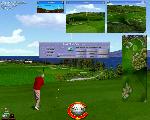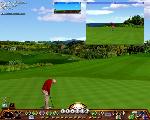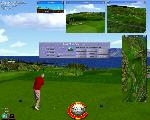 |
 This sequel
to Links 386 (itself a terrific game) promises an awful lot - including full
support for 32-bit color, a terrain-rendering system that models fairways with the care
that most games lavish only on greens, the ability to play Best Ball, Match Play, and
Skins formats, three great courses - Kapalua Plantation and Village and Arnold Palmer's
home course, the Latrobe Country Club, multiple camera angles, four different golfer
animations, and hole flyovers that also give advice on how to play the hole. But does it live up to these promises?
With that question in mind, Zap handed Links LS over to me, the middle-aged
duffer of the Games First! crew.
Before getting too far into this review, let me say
that this is a big game and it takes a lot of machine to run it. Though the game is
supposedly compatible with Windows 95, my Pentium 75 with 16 megs of RAM continually
crashed while trying to run the game under Windows 95; I've since run it in DOS with no
problems. Moral of story: stay clear of Windows '95 unless you've got 16+ megs of RAM.
The Look: This sequel
to Links 386 (itself a terrific game) promises an awful lot - including full
support for 32-bit color, a terrain-rendering system that models fairways with the care
that most games lavish only on greens, the ability to play Best Ball, Match Play, and
Skins formats, three great courses - Kapalua Plantation and Village and Arnold Palmer's
home course, the Latrobe Country Club, multiple camera angles, four different golfer
animations, and hole flyovers that also give advice on how to play the hole. But does it live up to these promises?
With that question in mind, Zap handed Links LS over to me, the middle-aged
duffer of the Games First! crew.
Before getting too far into this review, let me say
that this is a big game and it takes a lot of machine to run it. Though the game is
supposedly compatible with Windows 95, my Pentium 75 with 16 megs of RAM continually
crashed while trying to run the game under Windows 95; I've since run it in DOS with no
problems. Moral of story: stay clear of Windows '95 unless you've got 16+ megs of RAM.
The Look: This is probably the best-looking game I've
ever played, and I've been playing a lot of Quake lately. The screens are of
almost-photo quality and the animated golfers look, talk, and move like real humans. The
Hawaiian settings of the Kapalua courses are stunning, and the Latrobe course is rendered
just as breathtakingly. The game also has a pop-up menu screen that allows you to change
your clubs or stance easily and without cluttering up the screen. There is a slight
trade-off for the great look; it took my machine between 10-20 seconds to load screens
between shots. It didn't really bother me; this isn't hockey, after all, and it usually
takes me a lot longer than that to find my ball in real life. If you have a 166 MHz
Pentium, like my friend Al, the screens load immediately. The multiple camera angles give
you opportunities to view your shot from green, overhead, or side perspectives, and
there's nothing like using the reverse angle to replay that approach shot that ends up six
inches from the pin. Overall, Links LS delivers bigtime on the graphics end. But
a great-looking-game with lousy gameplay is no game at all.
Gameplay: This is probably the best-looking game I've
ever played, and I've been playing a lot of Quake lately. The screens are of
almost-photo quality and the animated golfers look, talk, and move like real humans. The
Hawaiian settings of the Kapalua courses are stunning, and the Latrobe course is rendered
just as breathtakingly. The game also has a pop-up menu screen that allows you to change
your clubs or stance easily and without cluttering up the screen. There is a slight
trade-off for the great look; it took my machine between 10-20 seconds to load screens
between shots. It didn't really bother me; this isn't hockey, after all, and it usually
takes me a lot longer than that to find my ball in real life. If you have a 166 MHz
Pentium, like my friend Al, the screens load immediately. The multiple camera angles give
you opportunities to view your shot from green, overhead, or side perspectives, and
there's nothing like using the reverse angle to replay that approach shot that ends up six
inches from the pin. Overall, Links LS delivers bigtime on the graphics end. But
a great-looking-game with lousy gameplay is no game at all.
Gameplay:How does this thing play? Like a dream, that's how. Like almost every other computer golf game ever made, the game models your swing in the classic click for backswing, click for snap format. This makes timing essential for a good shot, but with Links LS you've got to take other factors into account - like the hole's layout, aiming, playing a draw or not, the wind, the lie of your ball, and your choice of club - all the intangibles that make golf the horrible little highly addictive game that it is. Timing is essential in Links LS - too big of a backswing, or too early or late of a snap, and you'll be in the water. These are tough courses, and they don't suffer duffers gladly. (One sour note in this otherwise glowing review: even under DOS, the swing mechanism sometimes seemed to take on a life of its own - clicking early or late without any pressure from me. This may be due to my machine's speed; my pal's 166 has no such problem. In any case, I've since reloaded the game, and it's running well so far.)  One of the nicest
features of this game is the flyover feature; not only do you get a great view of the hole
you're about to play, but you also get a voiceover that gives you advice. Take it. If the
guy tells you to play your approach shot a club short, you can bet that you'll be long
otherwise. Aiming is a snap, and is best done by opening the overhead window. Trying to
aim from the golfer's view will just get you into trouble. Probably the toughest thing to
learn in this game, just like in real-life golf, is touch. There is no convenient distance
gauge on the swing meter; you just have to take into account the wind and club and your
own sense of feel. This can be frustrating early on, especially when you're in close to
the green and you hit it over again and again, but who hasn't had that experience on the
local greens? Fortunately for you, the program allows you to practice on any holes you
like, and a bit of this can give you a big advantage.
The game also allows you to create your own golfer,
to keep his or her statistics, and even to pick your favorite shirt color - you can even
play a tournament with Arnold Palmer as your playing partner. A nice touch.
The program has a lot of bells and whistles as well,
including 3D "Virtual Reality" and Video tours of the Kapalua Resort or its
clubhouse; it didn't do much for me, but you may like it.
Overall: One of the nicest
features of this game is the flyover feature; not only do you get a great view of the hole
you're about to play, but you also get a voiceover that gives you advice. Take it. If the
guy tells you to play your approach shot a club short, you can bet that you'll be long
otherwise. Aiming is a snap, and is best done by opening the overhead window. Trying to
aim from the golfer's view will just get you into trouble. Probably the toughest thing to
learn in this game, just like in real-life golf, is touch. There is no convenient distance
gauge on the swing meter; you just have to take into account the wind and club and your
own sense of feel. This can be frustrating early on, especially when you're in close to
the green and you hit it over again and again, but who hasn't had that experience on the
local greens? Fortunately for you, the program allows you to practice on any holes you
like, and a bit of this can give you a big advantage.
The game also allows you to create your own golfer,
to keep his or her statistics, and even to pick your favorite shirt color - you can even
play a tournament with Arnold Palmer as your playing partner. A nice touch.
The program has a lot of bells and whistles as well,
including 3D "Virtual Reality" and Video tours of the Kapalua Resort or its
clubhouse; it didn't do much for me, but you may like it.
Overall: A great game, probably the best sports game I've ever played. It's simple; it's fun; it's realistic. Even the non-golfers I've played this with have loved it; one is even thinking of taking up golf. The only negative thing I can think to say is that it probably takes more machine to run than Access admits; you may be able to run it on a 486, but I don't think it would be much fun. If you don't have the recommended system - Pentium 90, 16 megs, 4x CD-ROM - you should expect less than terrific gameplay. If you do, you're in for a treat. A classic. |